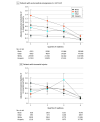Emergency Department Pediatric Readiness and Disparities in Mortality Based on Race and Ethnicity
- PMID: 37669053
- PMCID: PMC10481245
- DOI: 10.1001/jamanetworkopen.2023.32160
Emergency Department Pediatric Readiness and Disparities in Mortality Based on Race and Ethnicity
Abstract
Importance: Presentation to emergency departments (EDs) with high levels of pediatric readiness is associated with improved pediatric survival. However, it is unclear whether children of all races and ethnicities benefit equitably from increased levels of such readiness.
Objective: To evaluate the association of ED pediatric readiness with in-hospital mortality among children of different races and ethnicities with traumatic injuries or acute medical emergencies.
Design, setting, and participants: This cohort study of children requiring emergency care in 586 EDs across 11 states was conducted from January 1, 2012, through December 31, 2017. Eligible participants included children younger than 18 years who were hospitalized for an acute medical emergency or traumatic injury. Data analysis was conducted between November 2022 and April 2023.
Exposure: Hospitalization for acute medical emergency or traumatic injury.
Main outcomes and measures: The primary outcome was in-hospital mortality. ED pediatric readiness was measured through the weighted Pediatric Readiness Score (wPRS) from the 2013 National Pediatric Readiness Project assessment and categorized by quartile. Multivariable, hierarchical, mixed-effects logistic regression was used to evaluate the association of race and ethnicity with in-hospital mortality.
Results: The cohort included 633 536 children (median [IQR] age 4 [0-12] years]). There were 557 537 children (98 504 Black [17.7%], 167 838 Hispanic [30.1%], 311 157 White [55.8%], and 147 876 children of other races or ethnicities [26.5%]) who were hospitalized for acute medical emergencies, of whom 5158 (0.9%) died; 75 999 children (12 727 Black [16.7%], 21 604 Hispanic [28.4%], 44 203 White [58.2%]; and 21 609 of other races and ethnicities [27.7%]) were hospitalized for traumatic injuries, of whom 1339 (1.8%) died. Adjusted mortality of Black children with acute medical emergencies was significantly greater than that of Hispanic children, White children, and of children of other races and ethnicities (odds ratio [OR], 1.69; 95% CI, 1.59-1.79) across all quartile levels of ED pediatric readiness; but there were no racial or ethnic disparities in mortality when comparing Black children with traumatic injuries with Hispanic children, White children, and children of other races and ethnicities with traumatic injuries (OR 1.01; 95% CI, 0.89-1.15). When compared with hospitals in the lowest quartile of ED pediatric readiness, children who were treated at hospitals in the highest quartile had significantly lower mortality in both the acute medical emergency cohort (OR 0.24; 95% CI, 0.16-0.36) and traumatic injury cohort (OR, 0.39; 95% CI, 0.25-0.61). The greatest survival advantage associated with high pediatric readiness was experienced for Black children in the acute medical emergency cohort.
Conclusions and relevance: In this study, racial and ethnic disparities in mortality existed among children treated for acute medical emergencies but not traumatic injuries. Increased ED pediatric readiness was associated with reduced disparities; it was estimated that increasing the ED pediatric readiness levels of hospitals in the 3 lowest quartiles would result in an estimated 3-fold reduction in disparity for pediatric mortality. However, increased pediatric readiness did not eliminate disparities, indicating that organizations and initiatives dedicated to increasing ED pediatric readiness should consider formal integration of health equity into efforts to improve pediatric emergency care.
Conflict of interest statement
Figures

Comment in
-
Emergency Department Pediatric Readiness and the Search for Solutions That Promote Child Health Equity.JAMA Netw Open. 2023 Sep 5;6(9):e2332168. doi: 10.1001/jamanetworkopen.2023.32168. JAMA Netw Open. 2023. PMID: 37669056 No abstract available.
References
-
- Institute of Medicine . Emergency Care for Children: Growing Pains. National Academy Press; 2007.
-
- Emergency Medical Services for Children (EMSC) Innovation and Improvement Center . National pediatric readiness project. Accessed July 31, 2023. https://emscimprovement.center/domains/pediatric-readiness-project/
Publication types
MeSH terms
Grants and funding
LinkOut - more resources
Full Text Sources
Miscellaneous

